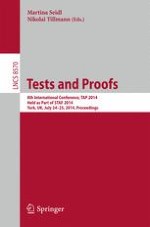2014 | Buch
Tests and Proofs
8th International Conference, TAP 2014, Held as Part of STAF 2014, York, UK, July 24-25, 2014. Proceedings
herausgegeben von: Martina Seidl, Nikolai Tillmann
Verlag: Springer International Publishing
Buchreihe : Lecture Notes in Computer Science
